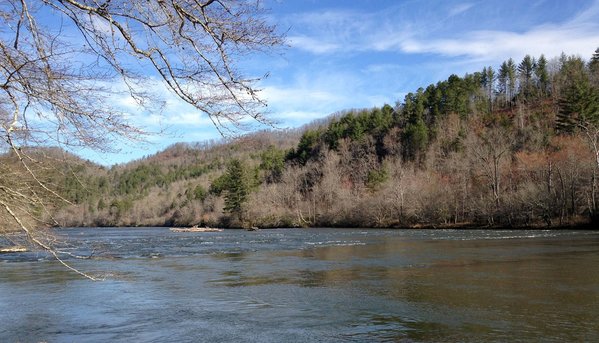Muir’s brief stop in the far western toe of NC

When on September 19, 1867, Muir reached North Carolina’s westernmost settlement of Murphy, he lingered only a single day to recover a bit from his strenuous mountain crossing. He poked around local groves and gorges, and noted his first recognition of the holly (Ilex) tree. Then he headed southward into Georgia. His route disappoints me, as much of my own career was dedicated to land conservation in North Carolina, and if only Muir had extended his tour of western North Carolina, I would have enjoyed describing the many conserved lands in that region of the Southern Appalachian and Blue Ridge Mountains. The story of land conservation and environmental preservation in western North Carolina is impressive and heroic.
You too may wish to linger in the vicinity of the old and charming Town of Murphy, the Cherokee County seat, and stroll along its 3-mile-long Murphy River Walk.
Today one has only a short way to travel further eastward on US Hwy 64 to reach the highway crossover of the Appalachian Trail coming from the mountains of north Georgia through the Nantahala National Forest and northward from Standing Indian Mountain toward Wayah Bald. The Nantahala National Forest in western North Carolina totals over 530,000 acres in size. Like Cherokee National Forest in Tennessee, the Nantahala was first established in 1920 under authority of the Weeks Act of 1911.
If one wants major diversions in their route (or inspirations for their future long hiking routes) in addition to the Appalachian Trail, you might explore all or parts of the 1,200-mile-long Mountains-to-Sea Trail in North Carolina, which transects that state from the Appalachian Trail in the Great Smoky Mountains National Park to Cape Hatteras National Seashore, and along its way passes through four national parks, three national forests, two national wildlife refuges, and ten state parks.
The Mainspring Conservation Trust is the regional, private land conservancy focused on saving more of the environmental resources and special natural areas in the southwestern counties of North Carolina, including the area where Muir once passed. Mainstream is doing impressive land and water resource conservation, often in partnership with the Eastern Band of the Cherokee and other groups in the region. Learn more about land conservation efforts in western North Carolina led by a consortium of private land trusts: for a directory and more information about North Carolina's land trusts consult the Conservation Trust for North Carolina.
Muir instead left Murphy without enjoying more of the high mountains of North Carolina and headed south into Georgia. To follow his path, bear back west from Murphy on US combined Highway 64/74/19/129, and take the southward turn on US Highway 19/129 toward Blairsville, GA.
>>>CONTINUE ON into Georgia . . .
You too may wish to linger in the vicinity of the old and charming Town of Murphy, the Cherokee County seat, and stroll along its 3-mile-long Murphy River Walk.
Today one has only a short way to travel further eastward on US Hwy 64 to reach the highway crossover of the Appalachian Trail coming from the mountains of north Georgia through the Nantahala National Forest and northward from Standing Indian Mountain toward Wayah Bald. The Nantahala National Forest in western North Carolina totals over 530,000 acres in size. Like Cherokee National Forest in Tennessee, the Nantahala was first established in 1920 under authority of the Weeks Act of 1911.
If one wants major diversions in their route (or inspirations for their future long hiking routes) in addition to the Appalachian Trail, you might explore all or parts of the 1,200-mile-long Mountains-to-Sea Trail in North Carolina, which transects that state from the Appalachian Trail in the Great Smoky Mountains National Park to Cape Hatteras National Seashore, and along its way passes through four national parks, three national forests, two national wildlife refuges, and ten state parks.
The Mainspring Conservation Trust is the regional, private land conservancy focused on saving more of the environmental resources and special natural areas in the southwestern counties of North Carolina, including the area where Muir once passed. Mainstream is doing impressive land and water resource conservation, often in partnership with the Eastern Band of the Cherokee and other groups in the region. Learn more about land conservation efforts in western North Carolina led by a consortium of private land trusts: for a directory and more information about North Carolina's land trusts consult the Conservation Trust for North Carolina.
Muir instead left Murphy without enjoying more of the high mountains of North Carolina and headed south into Georgia. To follow his path, bear back west from Murphy on US combined Highway 64/74/19/129, and take the southward turn on US Highway 19/129 toward Blairsville, GA.
>>>CONTINUE ON into Georgia . . .
